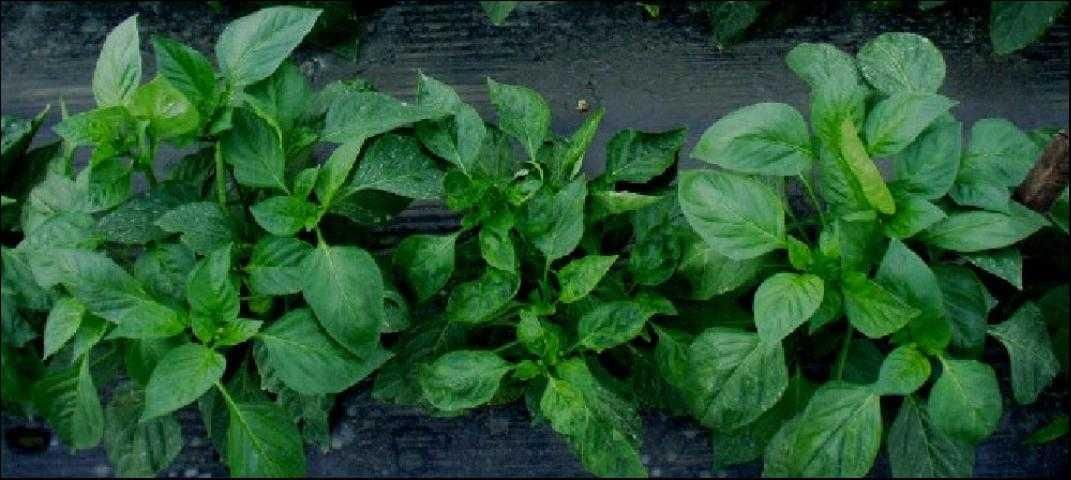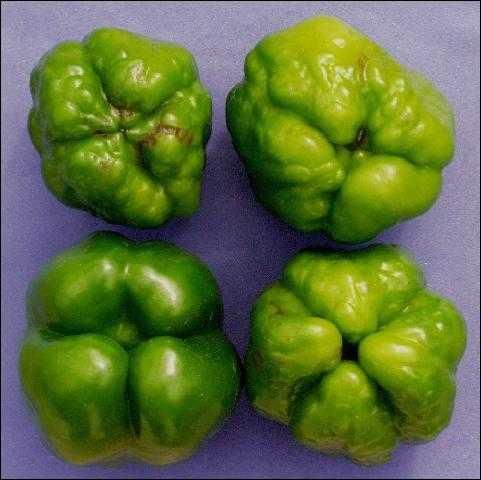Pepper mild mottle virus (PMMoV) occurs worldwide in field-grown bell, hot, and ornamental pepper species. The virus has also been found in greenhouse peppers in Canada, Italy, and Spain where greenhouse production practices are ideal for rapid spread of the disease. PMMoV was identified in commercial bell pepper fields in Florida in 2000. Disease incidence (the percentage of plants infected) of up to 30% was estimated in these Florida outbreaks. In subsequent years, PMMoV has appeared only sporadically in the state. Because foliar symptoms can be mild, infected plants may not be noticed until the fruit symptoms are evident, resulting in spread to neighboring plants and higher yield losses.
Causal Agent and Symptoms
PMMoV is in the tobacco mosaic virus (TMV or tobamovirus) family. It is spread by mechanical transmission and by contaminated seed. PMMoV is not transmitted by insects. The virus is identified by the symptoms it causes on indicator host plants, serological methods such as ELISA, and molecular techniques. A plant disease diagnostic clinic should be used to ensure accurate identification of the virus (see EDIS document PP-229, The Florida Plant Diagnostic Network).
Symptoms caused by PMMoV on pepper plants may vary between cultivars. Infected leaves are frequently puckered and mottled yellow or light green (Figure 1). Leaf symptoms are more evident on younger leaves.

Plants can be stunted, especially when the infection occurs early in the plant's development (Figure 2).

Although infected fruit can be reduced in size and show variations in color (mottling and color changes at maturity), the most obvious symptom is the distorted or lumpy appearance of the fruit (Figure 3). Older fruit may develop brown streaks or splotches.

Control
Avoidance is the best means of control. Only seed that has been tested and determined to be free of the virus should be planted. Contaminated seed can be treated with heat, acid, or trisodium phosphate to remove virus on the seed surface and ensure freedom from disease. Seed treatments can reduce the seed germination percentage even if done accurately.
Many cultivars and species of pepper (genus Capsicum) are susceptible to PMMoV because no virus resistance gene is present. However, this virus does not affect tomato eggplant or tobacco, which are in the same family (Solanaceae).
The virus enters the plant through microscopic abrasions or wounds. There are no chemical or biological control methods that can be used to control the disease once the plant is infected. Like other members of this family of viruses, the virus is very stable and can be present on skin, clothing, tools and equipment. Thus, infected plants should be handled as little as possible and infected fields should be worked (staked, tied, harvested, sprayed, etc.) last to avoid spreading the virus to non-infected areas. Infected plants should only be removed if elimination can be done without contact with healthy plants. A symptomless plant on either side of those removed should also be rogued, as it is likely that they are also infected. Tobamoviruses are known to spread through smoke so diseased plants should be disposed of by composting or burying them away from fields where peppers will be grown rather than by burning them.
Viruses in the tobacco mosaic virus family are notoriously easy to spread and difficult to eliminate. To reduce spread of the disease, anyone working with the plants should wash their hands with 70% alcohol or strong soap, also cleaning under the nails. Clothing should be washed as frequently as possible. Equipment should be washed and then cleaned with a saturated solution of trisodium phosphate and not rinsed. Stakes from infected areas of the field should be discarded or soaked in a saturated solution of trisodium phosphate before being reused. Household bleach or a 20% solution of non-fat dry milk can also be used to clean equipment or stakes.
Diseased plant material will remain infectious until completely degraded. Tillage, increased irrigation, and high temperatures encourage the breakdown of plant material in the soil. Any infected plant material in the soil can serve as a source of inoculum for subsequent crops so crop rotation should be practiced, if possible. Volunteer peppers and weeds, particularly those in the Solanaceae family (such as nightshades), should be removed to reduce possible sources of infections.